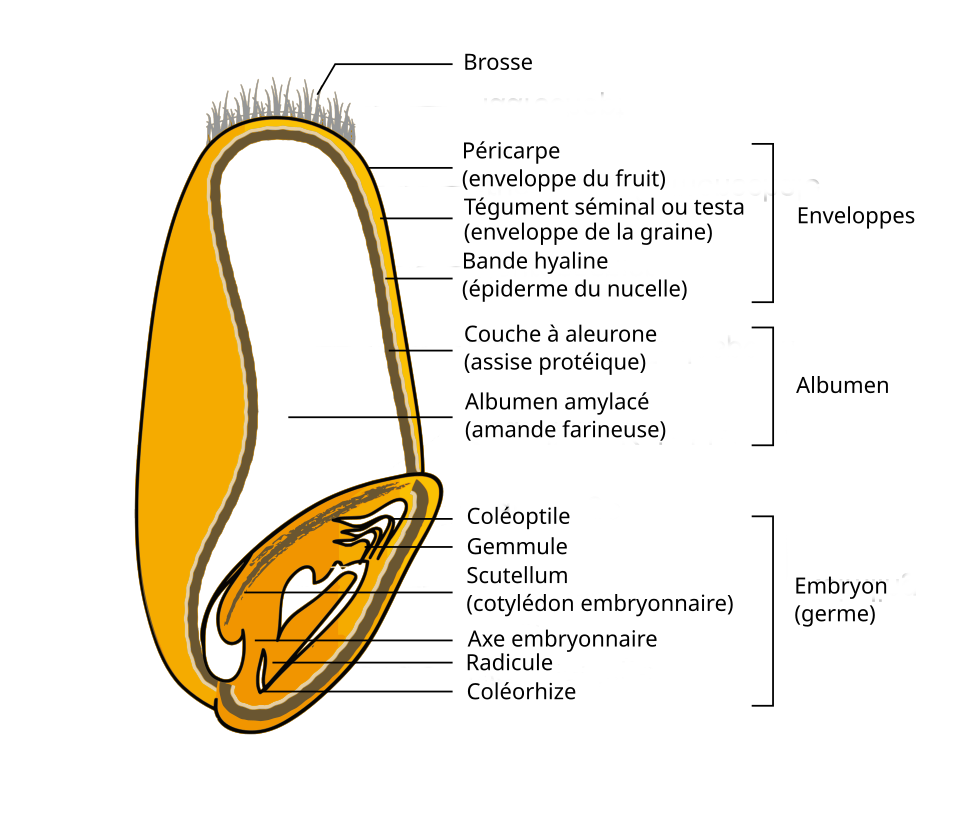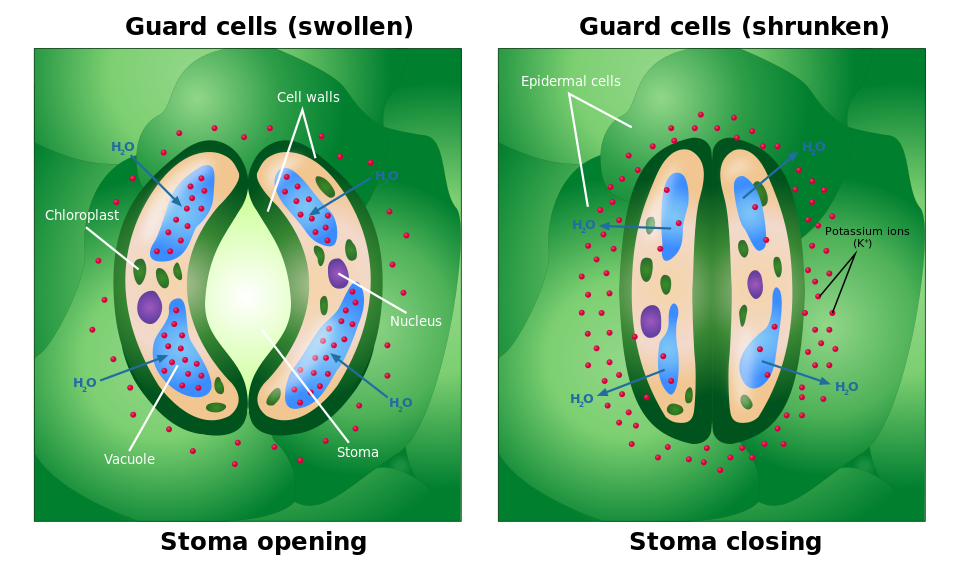OCR Specification focus:
‘Explain hormonal control of leaf loss in deciduous plants, seed germination and stomatal closure.’
Plant hormones, or plant growth regulators, are vital chemical messengers that coordinate growth, development and environmental responses. Their interactions control key processes like leaf loss, seed germination, and stomatal closure, ensuring survival and adaptation.
Hormonal Control of Leaf Loss in Deciduous Plants
The Need for Leaf Loss
Deciduous plants shed their leaves in response to seasonal changes—mainly decreasing light intensity and temperature. This conserves water and energy during winter when photosynthesis becomes less efficient. The process is called abscission, and it is tightly regulated by hormonal balance.
Role of Auxin and Ethene
Two main hormones, auxin and ethene (ethylene), interact antagonistically to control leaf fall.
Auxin is produced by young leaves and inhibits abscission by maintaining the integrity of cells in the abscission zone—a specialised layer at the base of the leaf stalk.
As a leaf ages, auxin production decreases, making cells in the abscission zone more sensitive to ethene.
Ethene stimulates enzymes such as cellulases and pectinases that digest the middle lamella and cell walls, weakening the connection between leaf and stem until the leaf detaches.
Abscission: The controlled separation of a leaf, fruit, or flower from the parent plant, often mediated by hormonal and enzymatic activity.
Protective Layer Formation
Before detachment, the cells on the stem side of the abscission zone form a protective layer impregnated with suberin, a waxy, waterproof material. This barrier prevents pathogen entry and water loss once the leaf falls.
Environmental and Hormonal Triggers
Falling temperatures and shorter photoperiods increase abscisic acid (ABA) and ethylene levels, promoting senescence and leaf drop. These hormonal shifts integrate environmental cues with internal chemical signals.
Falling auxin in the petiole increases ethylene sensitivity in the abscission zone; cell-wall-degrading enzymes separate cells while a suberised protective layer forms on the stem side.
Hormonal Control of Seed Germination
Hormone Balance in Dormant Seeds
Seeds remain dormant until environmental conditions favour germination. The balance between two antagonistic hormones—gibberellins (GAs) and abscisic acid (ABA)—determines whether a seed stays dormant or germinates.
ABA maintains seed dormancy, preventing premature germination.
Gibberellins break dormancy by stimulating the synthesis of enzymes that mobilise stored nutrients.
Dormancy: A period in which a viable seed does not germinate despite favourable environmental conditions, due to internal inhibitory mechanisms.
Mechanism of Gibberellin Action in Germination
Once conditions such as moisture and temperature are suitable, water uptake (imbibition) activates the embryo, which releases gibberellin.
Gibberellin diffuses into the aleurone layer of cereal grains, where it triggers transcription of genes encoding hydrolytic enzymes such as α-amylase. These enzymes digest starch stored in the endosperm into maltose and glucose, supplying energy for embryo growth.
Process summary:
Imbibition of water reactivates embryo metabolism.
Gibberellin synthesis increases in the embryo.
Gibberellin stimulates the aleurone layer to produce digestive enzymes.
Enzymes mobilise stored food, fuelling embryo growth and radicle emergence.
ABA–Gibberellin Interaction
The ratio of ABA to gibberellin is crucial. High ABA maintains dormancy; when environmental conditions are favourable, ABA levels fall and gibberellin levels rise, triggering germination. This balance exemplifies homeostatic hormonal regulation within plants.

Labeled wheat grain diagram highlighting the aleurone layer surrounding the endosperm. This structure is the GA-responsive tissue that secretes amylase to digest starch for the embryo. Labels are in French (e.g., “couche d’aleurone” for aleurone layer), but anatomy is universal and directly applicable to the syllabus. Source.
Hormonal Control of Stomatal Closure
Function of Stomata
Stomata are microscopic pores on leaf surfaces that regulate gas exchange and transpiration. They are controlled by pairs of guard cells that change shape to open or close the pore.
Transpiration: The loss of water vapour from a plant, mainly through the stomata in the leaves.
Role of Abscisic Acid (ABA) in Water Stress
During drought or high temperatures, abscisic acid acts as the primary signal initiating stomatal closure, preventing excessive water loss and maintaining water potential within safe limits.
Mechanism overview:
Water stress causes roots to release ABA into the xylem.
ABA is transported to leaves and binds to receptors on guard cell membranes.
ABA triggers the opening of ion channels, causing potassium (K⁺) and chloride (Cl⁻) ions to leave guard cells.
Loss of solutes decreases the osmotic potential of guard cells.
Water exits guard cells by osmosis, causing them to become flaccid and closing the stomatal pore.
Abscisic acid (ABA) triggers stomatal closure by promoting ion efflux from guard cells, lowering turgor so the pore narrows and water loss is reduced.

Opening and closing of a stoma depend on guard-cell turgor. ABA signalling causes ion efflux, water to leave the guard cells, and the pore to close, limiting transpiration. This diagram shows the coupled ion–water movements that underlie this response (extra detail beyond ABA signalling pathways is minimal and appropriate for A-level). Source.
Abscisic acid (ABA): A plant hormone that mediates stress responses, including stomatal closure and seed dormancy.
Integration of Environmental Signals
ABA levels rise rapidly in response to:
Drought and low soil water potential.
High salinity conditions.
Cold temperatures leading to frozen water in soil.
This rapid signalling ensures survival by conserving internal water and preventing wilting.
Interactions Between Hormones
Plant responses are rarely governed by a single hormone. Instead, synergistic and antagonistic interactions fine-tune responses.
Auxin and ethylene have opposite effects in leaf abscission.
Gibberellin and ABA act antagonistically in seed germination.
ABA and cytokinins often have opposing roles in water stress and leaf senescence.
These interactions allow plants to balance growth, reproduction, and survival, integrating internal developmental stages with environmental stimuli.
Summary of Key Hormonal Roles
Auxin: Prevents abscission; promotes growth in young tissues.
Ethene: Promotes leaf abscission and fruit ripening.
Abscisic acid (ABA): Maintains seed dormancy; induces stomatal closure during stress.
Gibberellins (GAs): Break seed dormancy and promote germination; stimulate stem elongation (not covered here).
Through these hormones, plants coordinate complex physiological changes essential for survival across fluctuating environments. Their precise regulation underpins key aspects of homeostasis, development, and environmental adaptation in plant biology.
FAQ
Environmental cues such as day length, temperature, and water availability affect hormone balance in leaves. Shorter days and cooler temperatures reduce auxin production in the leaf, increasing ethylene sensitivity in the abscission zone.
Drought or nutrient deficiency can accelerate this process as the plant reallocates resources. These signals ensure that leaves fall before conditions become unfavourable for photosynthesis or water retention.
Ethylene is unique among plant hormones because it is a gas, allowing it to diffuse freely through air spaces and between cells.
This property enables rapid communication between plant tissues, especially during coordinated events like fruit ripening or leaf abscission. In deciduous trees, ethylene produced by senescing leaves spreads locally to trigger abscission in neighbouring tissues, ensuring a synchronised leaf fall.
During extended water stress, ABA levels in both roots and leaves increase significantly. Roots detect reduced soil water potential and synthesise ABA, which travels via the xylem to shoots.
In leaves, elevated ABA concentrations signal guard cells to close stomata, conserving water. If the stress persists, ABA may also influence gene expression linked to drought tolerance and growth inhibition to minimise resource use.
Different plant species exhibit varying sensitivities to ABA, depending on their ecological niches and water availability.
Drought-tolerant species (e.g. cacti) have highly responsive guard cells that close rapidly at small increases in ABA concentration.
Mesophytic plants (e.g. many crops) require higher ABA levels for closure.
This variation reflects evolutionary adaptation, balancing water conservation with gas exchange efficiency under typical environmental conditions.
The aleurone layer not only secretes enzymes but also acts as a signalling interface between the embryo and endosperm.
It helps regulate nutrient flow, responding to gibberellin by activating genes for hydrolytic enzymes and by controlling storage protein breakdown.
Additionally, the aleurone plays a protective role, forming a barrier that manages metabolic exchange until the radicle and plumule begin independent growth.
Practice Questions
Question 1 (3 marks)
Explain how plant hormones regulate leaf abscission in deciduous plants.
Mark scheme (3 marks total)
Decrease in auxin from ageing leaves increases sensitivity of the abscission zone to ethylene.
Ethylene stimulates production of cell-wall-degrading enzymes (e.g. cellulases/pectinases) that separate cells in the abscission zone.
A protective layer forms on the stem side (suberin deposition), reducing water loss and pathogen entry after detachment.
Question 2 (5 marks)
Describe and explain the hormonal control of seed germination in cereals, including how stored food is mobilised. Your answer should refer to the antagonistic roles of key hormones.
Mark scheme (5 marks total)
Imbibition activates the embryo, which synthesises gibberellin (GA).
GA diffuses to the aleurone layer and induces transcription/translation of hydrolytic enzymes (e.g. α-amylase).
α-Amylase digests starch in the endosperm to maltose/glucose, supplying energy for embryo growth/radicle emergence.
Abscisic acid (ABA) maintains seed dormancy and acts antagonistically to GA; a shift to higher GA:ABA ratio promotes germination.
Clear linkage of hormone actions to outcome (enzyme production → reserve mobilisation → growth), using appropriate terminology (e.g. “antagonistic,” “aleurone,” “endosperm”).

